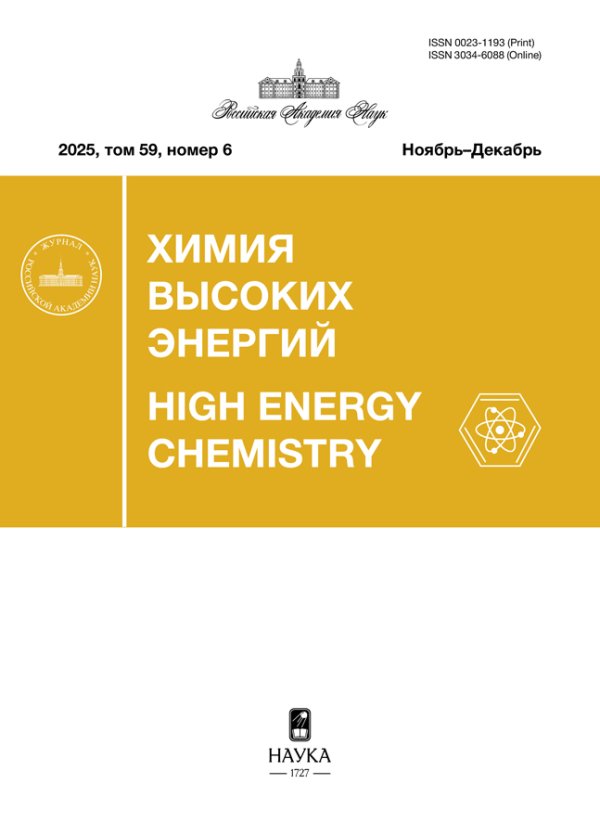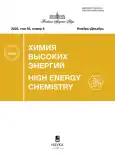Vol 59, No 6 (2025)
GENERAL QUESTIONS
STRUCTURE AND REACTIVITY OF CELLULOSE UNDER MICROWAVE EXPOSURE
Abstract
 375-381
375-381


ФОТОКАТАЛИЗ
EFFECT OF ULTRAVIOLET IRRADIATION ON THE PROPERTIES OF TITANIUM DIOXIDE AND PLATINUM-BASED CO CATALYST DEPOSITED ON POROUS NICKEL
Abstract
 382-388
382-388


RADIATION CHEMISTRY
EFFECT OF GAMMA IRRADIATION DOSE ON THE STRUCTURE OF POLYVINYL CHLORIDE POWDER
Abstract
 389-397
389-397


PARAMAGNETIC CENTERS STABILIZING IN RADIOLATED POLYSTYRENE
Abstract
 398-403
398-403


PLASMA CHEMISTRY
INFLUENCE OF PLASMA REACTOR MODES ON THE PROCESS OF ASPHALT-RESIN-PARAFFIN DEPOSITS PROCESSING
Abstract
 404-417
404-417


COMPARISON OF OXIDIZING CAPACITY OF NON-THERMAL PLASMA AND IONIZING RADIATION USING EPR SPECTROMETRY
Abstract
 418-424
418-424


PLASMA CHEMICAL SYNTHESIS OF METHANOL IN A BUBBLE REACTOR WITH METAL MELT
Abstract
 425-433
425-433


TRANSSONIC PLASMA SYSTEM FOR WATER DISINFECTION
Abstract
 434-439
434-439


НАНОДИСПЕРСНЫЕ СИСТЕМЫ И МАТЕРИАЛЫ
CONFORMATIONAL CHANGES IN THE STRUCTURE OF ADSORBED POLYELECTROLYTE CHAINS ON THE CHARGED SURFACE OF A SPHERICAL NANOPARTICLE
Abstract
 440-450
440-450


ЛАЗЕРНАЯ ХИМИЯ
STRUCTURAL FEATURES OF POLYVINYL ALCOHOL FILMS FORMED FROM AQUEOUS SOLUTION UNDER THE INFLUENCE OF LASER IRRADIATION OF VISIBLE WAVELENGTHS
Abstract
 451-458
451-458


MOLECULAR PHOTONICS
QUANTUM-CHEMICAL STUDY OF THE PENTAFLUORINATED DYE BORON DIFLUORIDE DIBENZOYLMETHANATE AND ITS EXCIPLEXES WITH BENZENE AND TOLUENE ON SILICA SURFACE
Abstract
TDDFT calculations of 5F-DBMBF2 exciplexes with benzene and toluene in the gas phase and on the silica gel surface were performed. The formation energies of exciplexes and adsorption energies of the dye on silica gel, as well as the transition wavelengths in the fluorescence spectra of isolated and adsorbed exciplexes were calculated. The presence of different in magnitude and oppositely directed spectral shifts upon the adsorption of DBMBF2 and 5F-DBMBF2 exciplexes on silica was shown. The values of of Mulliken charges on atoms, electron density transfer in the exciplexes, and its change upon the adsorption of the exciplexes on silica were calculated. It is shown that the introduction of fluorine atoms as a strong acceptors, into the DBMBF2 molecule leads to an increase in the interaction energy of the dye molecule with the silica surface and in the energy of formation of the exciplexes, increases electron density transfer in the exciplexes and the bathochromic shift of the exciplex fluorescence spectrum compared to the spectrum of the free dye. Calculations predict an extremely weak hypsochromic shift in the fluorescence spectra of 5F-DBMBF2 exciplexes with benzene and a weak bathochromic shift in the spectra of 5F-DBMBF2 exciplexes with toluene upon adsorption on silica.
 459-466
459-466


КРАТКИЕ СООБЩЕНИЯ НАНОДИСПЕРСНЫЕ СИСТЕМЫ И МАТЕРИАЛЫ
THIOACETAMIDE SOLUTION IN TRIBUTYLPHOSPHATE AS A SULFUR PRECURSOR FOR THE SYNTHESIS OF MONODISPERSE LEAD SULPHIDE QUANTUM DOTS
 467-470
467-470












